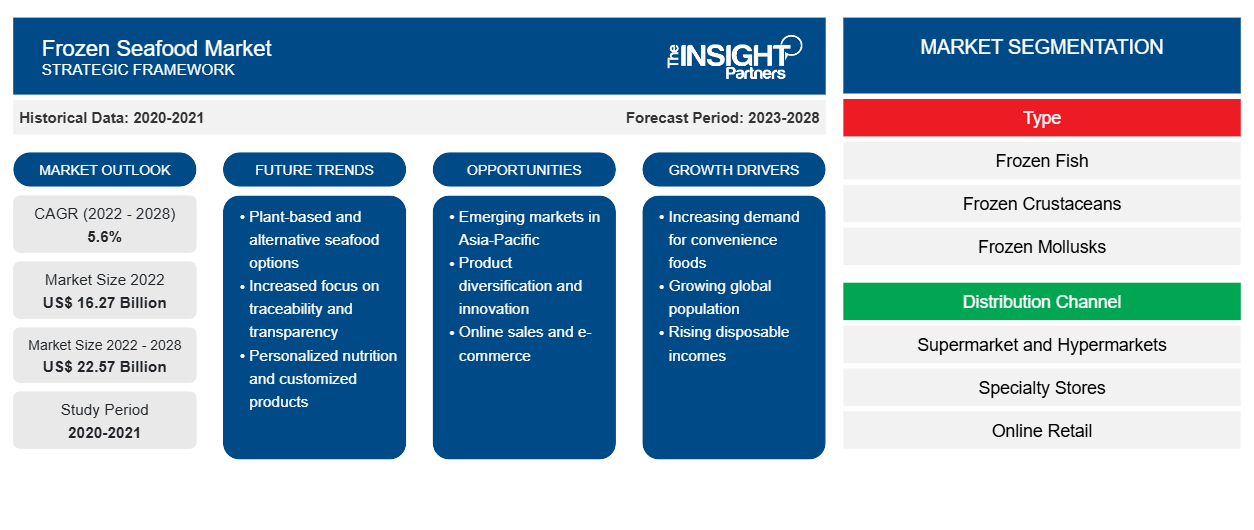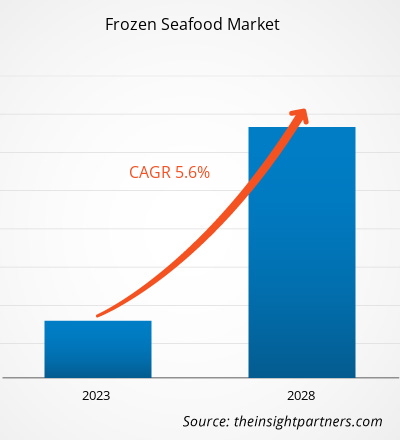The frozen seafood market is projected to reach US$ 22.57 billion by 2028 from US$ 16.27 billion in 2022. It is expected to grow at a CAGR of 5.6% during 2022-2028.
The frozen seafood market demand increased owing to increasing health consciousness among consumers, along with the increasing awareness regarding the benefits of consuming frozen seafood products. Most people nowadays have a busy lifestyle and want to live a healthy one. Frozen seafood provides convenience to cook and also provides essential nutrients for the human body and brain. Additionally, frozen seafood products are less expensive and have a long shelf life. All these factors are projected to drive the growth of the market during the forecast period.
The market size is projected to witness significant growth in the coming years due to the strong presence of prominent players, such as Thai Union Group, Sterling Seafood, and Clifton Seafood Company, operating actively worldwide. A large variety of frozen seafood products gained consumers' attention. There has been a growing trend among consumers toward consuming packaged food products, leading to the frozen seafood market growth. This factor is projected to offer new opportunities to frozen seafood product manufacturers during the forecast period.
In 2021, Asia Pacific held the key share of the global frozen seafood market. However, North America is estimated to register the highest CAGR in the market during the forecast period. The Asia Pacific market is segmented into China, India, Australia, Japan, South Korea, and the Rest of Asia Pacific. The seafood industry is one of the booming industries in Asia Pacific due to the availability and health benefits associated with seafoods. Consumers in developing countries are experiencing a sharp increase in their disposable income, raising their purchasing power. Various seafood products, including frozen seafood products, are witnessing a surge in demand. The rising disposable income levels of consumers and the growth of the middle-class population are among the key factors driving the frozen seafood market demand in the region.
Customize This Report To Suit Your Requirement
You will get customization on any report - free of charge - including parts of this report, or country-level analysis, Excel Data pack, as well as avail great offers and discounts for start-ups & universities
Frozen Seafood Market: Strategic Insights

-
Get Top Key Market Trends of this report.This FREE sample will include data analysis, ranging from market trends to estimates and forecasts.
Impact of COVID-19 Pandemic on Frozen Seafood Market
Before the COVID-19 pandemic, the frozen seafood market growth was primarily driven by the rising demand for food products with high nutritional value. However, the market faced hurdles during the first quarter of 2020 due to business shutdown and raw material and labor shortages. The COVID-19 pandemic led to economic recession in the initial months of 2020, which created financial difficulties for low-income and mid-income consumers.
Moreover, due to restrictions, people stayed at home and cooked at home, creating a demand for packaged food products that are easy to cook and quality. Consumers also became health conscious and preferred food products that provided essential nutrients, which increased the market growth during the COVID-19 pandemic.
Market Insights
Benefits of Consuming Frozen Seafood
Consuming frozen seafood provides various health benefits. It consists of minerals, vitamins, and omega - 3, among others, essential for the human body and brain. It reduces the risk of heart attacks and strokes, improves eyesight, treats depression, improves brain health, improves skin and hair texture, and improves the immune system. Freezing seafood products increase the shelf life of seafood products and maintain the quality of the seafood for a longer duration.
Frozen seafood is available in a wide range, and people can choose from a large portfolio according to their needs. It is also convenient to cook, and it also avoids wastage.
Category Insights
Based on product type, the global market is segmented into frozen fish, frozen crustaceans, frozen mollusks, and others. In 2021, the frozen fish segment accounted for the largest revenue share and is expected to account for the highest growth rate over the forecast period. A typical source of high-quality protein is fish. In addition to having higher levels of omega-3 fatty acids and Vitamins D and B2 (riboflavin), fish is also lower in calories, saturated fats, and cholesterol than other foods. In addition to being an excellent source of minerals like iron, zinc, iodine, magnesium, and potassium that can lower blood pressure and help lessen the risk of a heart attack or stroke, fish is also high in calcium and phosphorus.
Thai Union Group, Sterling Seafood Corp., Clifton Seafood Company, Marine Foods, Viet Asia Foods Company, American Seafoods, Mazetta Company LLC, High Liner Foods Inc, The Sirena Group, and Castlerock Fisheries Pvt. Ltd. are the players operating in the market. These companies provide a wide range of product portfolios for the market. The companies have their presence in developing regions, providing lucrative market opportunities. Market players are developing high-quality, innovative products to meet customer requirements.
Frozen Seafood Market Regional InsightsThe regional trends and factors influencing the Frozen Seafood Market throughout the forecast period have been thoroughly explained by the analysts at The Insight Partners. This section also discusses Frozen Seafood Market segments and geography across North America, Europe, Asia Pacific, Middle East and Africa, and South and Central America.
Frozen Seafood Market Report Scope
| Report Attribute | Details |
|---|---|
| Market size in 2022 | US$ 16.27 Billion |
| Market Size by 2028 | US$ 22.57 Billion |
| Global CAGR (2022 - 2028) | 5.6% |
| Historical Data | 2020-2021 |
| Forecast period | 2023-2028 |
| Segments Covered |
By Type
|
| Regions and Countries Covered |
North America
|
| Market leaders and key company profiles |
|
Frozen Seafood Market Players Density: Understanding Its Impact on Business Dynamics
The Frozen Seafood Market is growing rapidly, driven by increasing end-user demand due to factors such as evolving consumer preferences, technological advancements, and greater awareness of the product's benefits. As demand rises, businesses are expanding their offerings, innovating to meet consumer needs, and capitalizing on emerging trends, which further fuels market growth.

- Get the Frozen Seafood Market top key players overview
Report Spotlights
- Progressive industry trends in the market to help players develop effective long-term strategies
- Business growth strategies adopted by developed and developing markets
- Quantitative analysis of the frozen seafood products market size from 2020 to 2028
- Estimation of global frozen seafood market demand
- PEST analysis to illustrate the efficacy of buyers and suppliers operating in the industry
- Recent developments to understand the competitive market scenario
- Market trends and outlook and factors driving and restraining the growth of the frozen seafood market
- Assistance in the decision-making process by highlighting market strategies that underpin commercial interest, leading to the market growth
- The size of the frozen seafood market size at various nodes
- Detailed overview and segmentation of the market, as well as the frozen seafood industry dynamics
- Frozen seafood market size in various regions with promising growth opportunities
The "Frozen Seafood Market Analysis to 2028" is a specialized and in-depth study of the consumer goods industry with a special focus on the global frozen seafood market trend analysis. The report aims to provide an overview of the market with detailed market segmentation.
The frozen seafood market is analyzed based on type, distribution channel, and geography. Based on type, the global frozen seafood market is segmented into frozen fish, frozen crustaceans, frozen mollusks, and others. Based on distribution channel, the global frozen seafood market is segmented into supermarkets and hypermarkets, specialty stores, online retail, and others. By geography, the market is broadly segmented into North America, Europe, Asia Pacific (APAC), the Middle East & Africa (MEA), and South and Central America.
Company Profiles
Thai Union Group, Sterling Seafood Corp., Clifton Seafood Company, Marine Foods, Viet Asia Foods Company, American Seafoods, Mazetta Company LLC, High Liner Foods Inc, The Sirena Group, and Castlerock Fisheries Pvt. Ltd. are the prominent players operating in the global frozen seafood market.
Frequently Asked Questions
What are the trends observed in the global frozen seafood market?
Based on the distribution channel, which segment led the global frozen seafood market in 2021?
Which type segment is the fastest growing in the frozen seafood globally?
What are the drivers for the growth of the global frozen seafood market?
Can you list some major players operating in the global frozen seafood market?
In 2021, which region held the largest share of the global frozen seafood market?
- Historical Analysis (2 Years), Base Year, Forecast (7 Years) with CAGR
- PEST and SWOT Analysis
- Market Size Value / Volume - Global, Regional, Country
- Industry and Competitive Landscape
- Excel Dataset
Recent Reports
Related Reports
Testimonials
Reason to Buy
- Informed Decision-Making
- Understanding Market Dynamics
- Competitive Analysis
- Identifying Emerging Markets
- Customer Insights
- Market Forecasts
- Risk Mitigation
- Boosting Operational Efficiency
- Strategic Planning
- Investment Justification
- Tracking Industry Innovations
- Aligning with Regulatory Trends





















 Get Free Sample For
Get Free Sample For